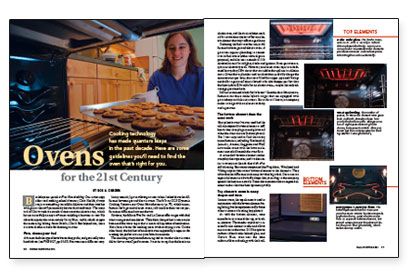Ovens for the 21st Century
Cooking technology has made quantum leaps in the past decade. Here are some guidelines you'll need to find the oven that's right for you.

Synopsis: This overview of ovens examines how electric and gas ovens work, compares their performance, and describes the important features to look for when choosing a wall or range oven for your kitchen. Included is a sidebar on convection ovens.
Birthdays are special at Fine Homebuilding. Our senior copy editor and cooking-school alumnus, Chris Hoelck, always conjures something incredibly delicious and then watches with glee as the staff passionately devours his handiwork. The main tool of Chris’s trade is a standard non convection electric oven, which he uses as artfully as any craftsman wielding a hammer or saw. He chose this particular oven mainly for its 36-in. width, which accepts those extra-big baking sheets (thanks, Chris). But beyond size, there are several other criteria for choosing an oven.
First, choose your fuel
Ask most chefs the type of stove burner they prefer, and gas usually wins hands down. But ovens are a different story.
In my research, I got conflicting answers when I asked about the difference between gas and electric ovens. The folks at DCS (Dynamic Cooking Systems), which manufactures both gas and electric ovens, told me that there was no performance difference between the two.
However, the folks at Five Star and La Cornue offer ranges with dual ovens: one gas and one electric. They claim that gas heat is more moist because of the water vapor that is a natural by product of combustion. Moist heat is better for cooking meat without drying it out. On the other hand, the dry heat of an electric oven supposedly is superior for creating the perfect crust on your favorite casserole.
The one thing every manufacturer agreed on was that electric ovens deliver better overall performance. It’s easier to regulate the heat in an electric oven, and the air circulation needed for convection doesn’t affect an electric element the way it affects a gas flame.
Delivering the fuel is another major difference between gas and electric ovens. A gas oven requires plumbing to connect it to its fuel source (either natural gas or propane), and also uses a standard 110v electrical circuit for its lights, clocks and ignition. Some gas ovens require no electricity at all. However, an electric oven requires a dedicated heavy-duty 220v circuit that can add to the upfront installation costs. Given that a plumber and an electrician probably charge the same amount per hour, the cost of flexible copper pipe and fittings needed for a gas installation is bound to be a lot cheaper per foot than the heavy-duty 220v cable for an electric oven — maybe the only advantage gas ovens have.
Still not convinced which fuel is better? Consider this: Many manufacturers out there make hybrid ranges that are equipped with gas cooktops and electric ovens. But as far as I know, no company makes a range with an electric cooktop and a gas oven.
The bottom element does the most work
Every electric oven I’ve ever used had the tell-tale exposed bottom element: a stiff, heavy wire that plugs in and glows red when the oven is in use. But I was surprised to find that many manufacturers, including KitchenAid, Jenn-Air, Amana, Gaggenau and Wolf, now make ovens with the bottom element concealed beneath the oven floor.
For more photos, illustrations, and details, click the View PDF button below:
Fine Homebuilding Recommended Products
Fine Homebuilding receives a commission for items purchased through links on this site, including Amazon Associates and other affiliate advertising programs.

Code Check 10th Edition: An Illustrated Guide to Building a Safe House

Homebody: A Guide to Creating Spaces You Never Want to Leave

Musings of an Energy Nerd: Toward an Energy-Efficient Home






















